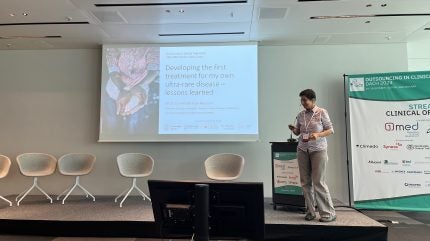
When Dr Jasmin Barman-Aksӧzen began experiencing painful, unexplained burns on her skin, she turned to Wikipedia for answers. After discovering a possible diagnosis, she proposed it to her physician who confirmed that she had erythropoietic protoporphyria (EPP).
This ultra-rare genetic disorder causes a phototoxic heme precursor to build up in the red blood cells, resulting in severe burn injuries on the skin after as little as ten minutes of exposure to visible light. At the time of her diagnosis, no treatment existed to alleviate or prevent the symptoms of EPP.
“There was no cure, there was no therapy for the pain, and there were no preventive possibilities for this phototoxic reaction, so the only thing we could do was avoid visible light. As you can imagine, that’s socially very isolating, and it’s not compatible with a normal life, and having to avoid light also leads to depression. We sometimes see suicidal ideations,” she explained.
Around the same time, Australia-based biotech Clinuvel Pharmaceuticals was in the process of developing afamelanotide – a slow-release treatment now known as Scenesse. The drug increases skin pigmentation and has anti-inflammatory properties, offering protection against light-induced skin damage.
Speaking at the Outsourcing in Clinical Trials (OCT) DACH 2024 conference, taking place in Zurich, Switzerland, between 29 and 30 October, Barman-Aksӧzen explained that she joined a University of Zurich research group working on Scenesse as a PhD student. The treatment was already in Phase III trials, and she provided insights on clinical trial design and quality of life (QoL) measures for patients with EPP.
The results from the pivotal trial (NCT01605136) showed that patients receiving Scenesse could spend, on average, an additional 20 minutes in sunlight daily without experiencing pain, compared to those on a placebo. Maximally, the patients can spend up to three hours a day in sunlight while using the treatment. They also experienced fewer phototoxic reactions, with symptoms that were less intense and shorter in duration, leading to an overall improvement in quality of life.
Though an additional 20 minutes of sun exposure a day may sound minimal, Barman-Aksӧzen highlighted how significant this can be for patients with EPP. Recalling a trip to Berlin, she shared that, without treatment, she wouldn’t have been able to take a taxi with a sunroof without risking a severe phototoxic reaction. “Those are the moments when we are really happy to have the treatment,” she explained.
Data from this clinical trial led to Scenesse receiving European approval in 2014. Notably, Barman-Aksӧzen became the first patient to present directly to the European Medicines Agency (EMA) committee before its approval vote, offering insights that clarified both the condition and the treatment’s impact. The EMA subsequently announced that Scenesse was the first drug approved through a European pilot programme that incorporated patient and physician clinical experiences in regulatory decisions – an approach now more widely adopted.
In 2019, the US Food and Drug Administration (FDA) followed with its own approval of the drug.
Barman-Aksӧzen continues her work advocating for EPP patients and co-founded the International Porphyria Patient Network (IPPN) alongside other patient advocates.
While Scenesse brought a treatment option to EPP patients, Barman-Aksӧzen underscored its limitations; it’s a fixed-dose implant for symptomatic relief, which is not scalable and cannot be used for children.
Two new candidates, Mitsubishi’s dersimelagon and Disc Medicine’s bitopertin, are being evaluated in clinical trials. These trials present ethical challenges such as the potential for phototoxic burns in control groups, and the risk of a bias in patient selection, as more severely affected patients may hesitate to participate.
Barman-Aksӧzen added: “As patients, we’ve requested head-to-head studies. Besides the ethical aspects, I, as a patient, want to know how a new substance compares not only to placebo but also to the existing therapy.”



